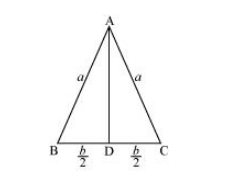The two equal sides of an isosceles triangle with fixed base b are decreasing at the rate of 3 cm per second. How fast is the area decreasing when the two equal sides are equal to the base?
Let ΔABC be isosceles where BC is the base of fixed length b.
Let the length of the two equal sides of ΔABC be a.
Draw $A D \perp B C$.

Now, in ΔADC, by applying the Pythagoras theorem, we have:
$\mathrm{AD}=\sqrt{a^{2}-\frac{b^{2}}{4}}$
$\therefore$ Area of triangle $(A)=\frac{1}{2} b \sqrt{a^{2}-\frac{b^{2}}{4}}$
The rate of change of the area with respect to time (t) is given by,
$\frac{d A}{d t}=\frac{1}{2} b \cdot \frac{2 a}{2 \sqrt{a^{2}-\frac{b^{2}}{4}}} \frac{d a}{d t}=\frac{a b}{\sqrt{4 a^{2}-b^{2}}} \frac{d a}{d t}$
It is given that the two equal sides of the triangle are decreasing at the rate of 3 cm per second.
$\therefore \frac{d a}{d t}=-3 \mathrm{~cm} / \mathrm{s}$
$\therefore \frac{d A}{d t}=\frac{-3 a b}{\sqrt{4 a^{2}-b^{2}}}$
Then, when a = b, we have:
$\frac{d A}{d t}=\frac{-3 b^{2}}{\sqrt{4 b^{2}-b^{2}}}=\frac{-3 b^{2}}{\sqrt{3 b^{2}}}=-\sqrt{3} b$
$\frac{d A}{d t}=\frac{-3 b^{2}}{\sqrt{4 b^{2}-b^{2}}}=\frac{-3 b^{2}}{\sqrt{3 b^{2}}}=-\sqrt{3} b$
Hence, if the two equal sides are equal to the base, then the area of the triangle is decreasing at the rate of $\sqrt{3} b \mathrm{~cm}^{2} / \mathrm{s}$.
